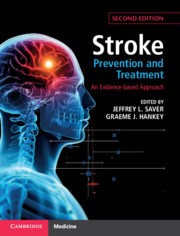Book contents
- Stroke Prevention and Treatment
- Stroke Prevention and Treatment
- Copyright page
- Dedication
- Contents
- Contributors
- Preface
- Part I Foundations
- Part II Systems of Care
- Part III Acute Treatment of Ischaemic Stroke and Transient Ischaemic Attack
- Part IV Acute Treatment of Haemorrhagic Stroke
- Chapter 13 Acute Treatment of Intracerebral Haemorrhage
- Chapter 14 Acute Treatment of Subarachnoid Haemorrhage
- Part V Prevention
- Part VI Stroke Rehabilitation and Recovery
- Index
- References
Chapter 14 - Acute Treatment of Subarachnoid Haemorrhage
from Part IV - Acute Treatment of Haemorrhagic Stroke
Published online by Cambridge University Press: 15 December 2020
- Stroke Prevention and Treatment
- Stroke Prevention and Treatment
- Copyright page
- Dedication
- Contents
- Contributors
- Preface
- Part I Foundations
- Part II Systems of Care
- Part III Acute Treatment of Ischaemic Stroke and Transient Ischaemic Attack
- Part IV Acute Treatment of Haemorrhagic Stroke
- Chapter 13 Acute Treatment of Intracerebral Haemorrhage
- Chapter 14 Acute Treatment of Subarachnoid Haemorrhage
- Part V Prevention
- Part VI Stroke Rehabilitation and Recovery
- Index
- References
Summary
Aneurysmal SAH is a severe disease, and the post-haemorrhage period fraught with potential complications that must be recognized and treated early for favourable outcome. While diagnosis of SAH is often straightforward from clinical history and initial CT, some patients will require cerebrospinal fluid evaluation. The aneurysm must be secured urgently to reduce rerupture and clinical worsening. Endovascular coiling is preferable when feasible, but surgical clipping is sometimes needed based on patient or aneurysmal characteristics, or presence of intraparenchymal haemorrhage requiring evacuation. Treatment of symptomatic hydrocephalus with CSF diversion is also crucial. Patients with aneurysmal SAH should be managed by a team of nurses and physicians with neurocritical care, neuroendovascular, and neurosurgical expertise, preferably in a dedicated neurosciences intensive care unit. Early complications include aneurysmal rebleeding, hydrocephalus, and neurogenic cardiopulmonary injury. In the subacute phase, delayed cerebral ischaemia and hyponatremia are more commonly seen. With optimal multidisciplinary management, many patients can return to their previous level of function only weeks after the aneurysm rupture. Still, most treatments in SAH are based on insufficient evidence, and more collaborative research from the bench to the bedside is necessary to continue improving patient outcomes.
Keywords
- Type
- Chapter
- Information
- Stroke Prevention and TreatmentAn Evidence-based Approach, pp. 260 - 288Publisher: Cambridge University PressPrint publication year: 2020



